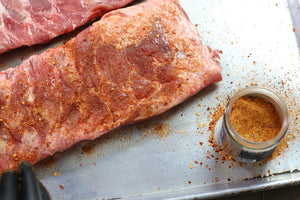BBQ Rubs 101: Different Types & How to Use Them
Some pitmasters swear that all you need is a little salt and pepper. Which is true for some cuts of meat, but even a high-quality steak is better with a crunchy coating of coarse spices (or at least we think so). Other cuts of meat are not as flavorful on their own and are enhanced when paired with a salty-smoky-sweet seasoning. If you’re new to ‘que, our rubs guide will walk you through all the basics to create mouthwatering meats.
What’s in a Rub?
Let's start with the basics: what are dry rubs made of? Well, beyond your standard base of salt, rubs typically contain a sweetener in the form of either white or brown sugar, honey granules, or dried molasses. The sweetness is a flavor enhancer and helps with browning and crust formation. Other classic ingredients typically include garlic and onion powder, chili powder, mustard and paprika.
No matter your type of rub, it’s important for it to have a good deal of color in it from paprika or chili, as smoking your meat low and slow won’t cause a direct Maillard reaction as searing or grilling does.

Wet Rubs vs. Dry Rubs
Dry rubs are a mixture of spices and dried herbs that are rubbed directly into the meat before cooking. The juices of the meat will mix with the rub and create a smoky and sweet exterior that complements the natural flavor of the meat when eaten together.
So can you make a wet rub from a dry rub? Yes! To make a wet rub, you can simply mix your dry rub with an equal amount of oil until a paste is formed, then apply directly to the meat. Oil won’t evaporate during the cooking process and will help your seasoning better adhere to the meat. Instead of oil, you can also use apple cider vinegar, mustard, apple cider or even a beer to form the base.
In short, the difference between a dry and a wet rub is that extra wet component, usually making the bbq rub adhere to the meat better. Make sure you pick the right bbq seasoning to get the best results!
Is dry rub better than marinade?
As always, which type of rub is the best really depends on your personal preferences. Dry rubs are best to get a light crust on the outer layer of the meat, packed with flavor and locking in juiciness. On the other hand, marinades tenderize the meat and allow the spices to sip in deeper into the meat.
Check out our BBQ sauce 101 article to try your hand at marinading!
How to Apply a Dry Rub
Now that you know everything about the different types of rubs, here's how to use dry rubs. A dry rub can be rubbed directly into the meat and massaged until it sticks to the surface. We recommend patting your cut of meat dry using paper towels. From there, you can season directly onto the meat or apply a small amount of oil over the surface before coating generously in the dry rub. Depending on the cut of meat, you can let it rest for 30 minutes to an hour at room temperature before cooking.
If you’re smoking a larger cut like a pork shoulder, brisket or ribs, we recommend applying a thin layer of mustard or hot sauce to the surface of the meat before adding your rub. This will help the rub adhere to the surface while increasing the moisture. If you’re using a really fine grain rub (like our Jackpot Honey Mustard), the bbq seasoning particles will adhere right to the meat.

Always make sure to pour the amount of rub needed in a small bowl before applying to the meat. You don't want to dip wet hands into your jar, which can cause clumping and contamination. Another method is to have a “sprinkling hand” and a “meat hand” so one hand touches the meat and the other only touches seasoning.

Creating Bark
Bark is the flavor-packed crust-like substance that forms on the outside of meat when it’s cooked low and slow. The bark results from a combination of BBQ rub, caramelized sugar, rendered fat and smoke that is cooking and creating a chemical reaction on the surface of the meat. The uncooked juices that then lie on the surface of the meat mingle with the BBQ rub and cook in place, forming a protein network infused with flavor.

An easy way to test your bark before wrapping is to scratch it with your fingernail. If it adheres to the meat, you’re safe to wrap. If it comes off the meat easily, put it back in to cook longer.
Grab a jar of our Notorious P.I.G BBQ dry rub. and follow our tutorial for Smoked Pork Shoulder.
A Rub for Every Protein
Not all rubs are created equal, just like the foods you use them on do not taste the same. Certain spices and herbs are better complemented to different types of proteins. Our new line of rubs was specifically formulated for the things you BBQ the most, plus a few game-changers that'll get your creative juices flowing.

Rodeo Rub:
Compared to other proteins, beef is a rich-tasting meat that is best paired with smoky flavors that enhance it. This blend starts with the basics: brown sugar, sea salt, black pepper, paprika, then has Texas-inspired flavors of chili pepper, garlic, cumin and hickory smoke.
Jackpot Rub:
Inspired by the tangy mustard-based flavors of Carolina Gold BBQ, this dry rub has a base of fine honey granules and mustard powder, rounded out with garlic, onion and other spices. The fine texture of this rub makes it perfect for creating a paste-like coating that complements the flavors of smoked pork or chicken.
Notorious P.I.G:
Pork has a naturally mild and sweet flavor that can be paired with a variety of flavors. For a classic BBQ'd pork flavor and color, we combined brown sugar, chili pepper, garlic, chipotle pepper and hickory smoke flavor for our BBQ rub. This blend gets an extra kick and visual element from whole crushed red pepper flakes. But don't let the name hold you back, we've used this blend on beef and chicken and both were equally delicious.

Apple Pie:
Inspired by one of our best-selling rubs, this blend is a combination of sweet pie spices like cinnamon and clove blended with brown sugar, butter flavors and a hint of apple. The sweetness of this blend makes it perfect on all cuts of pork, but would be great on chicken too.
Honky Tonk:
Nashville Hot Chicken is the new Buffalo chicken. We packed the flavor of this spicy fried chick into a dry rub with real buttermilk and hot sauce. This red hot blend is great swirled into cornbread, mixed into batters or breadings or dry-rubbed right on chicken wings or ribs.
Cock-A-Doodle Brew:
The flavors of Beer Can Chicken bottled up into a dry rub, this malty blend has a base of salt, sugar and honey mixed with garlic, beer, hickory smoke and some parsley for an herby finish. We like this blend on chicken and pork, but it can pair with beef and fish as well.
Caesar Style Wing Rub
Craving garlic parmesan wings? PS Seasoning's Caesar Style can help you. This dry rub for chicken wings is a must-have for any backyard barbecue. This creamy blend of parmesan, garlic, and black pepper with a hint of lemon will command your taste buds. When in Rome, eat like an emperor.
Buffalo Cajun Hot Wings Dry Rub
Watch your back! There's a herd of flaming hot flavor stampeding towards you from the bayou. This Cajun buffalo dry rub for wings is so packed with cayenne, butter, and Creole seasonings that it'll have you shouting "geaux-tcha" in no time. Better grab some milk before you take a bite or you might end up breathing fire like a dragon.


